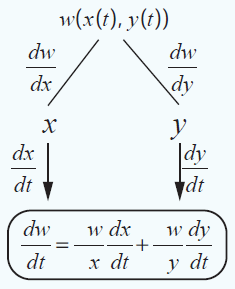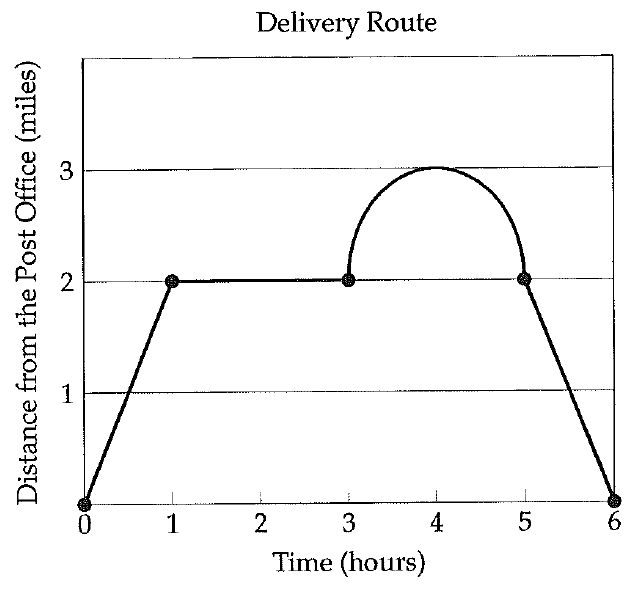PROBLEMS ON CHAIN RULE IN PARTIAL DIFFERENTIATION
Suppose that W(x, y) is a function of two variables x, y having partial derivatives ∂W/∂x, ∂W/∂y. If both variables x, y are differentiable functions of a single variable t, then W is differentiable function t and

Problem 1 :
If
w(x, y) = 6x3-3xy+2y2, x = es, y = cos s, s ∈ ℝ
find dw/ds, and evaluate at s = 0.
Solution :
dw/ds = (∂w/∂x) (dx/ds) + (∂w/∂y) (dy/ds)
|
∂w/∂x = 6(3x2)-3(1)y+0 ∂w/∂x = 18x2-3y dx/ds = es |
∂w/∂y = 0-3x(1)+2(2y) ∂w/∂y = -3x+4y dy/ds = -sin s |
Applying the values in the formula, we get
= (18x2-3y)(es) + (-3x+4y)(-sin s)
= (18e2s-3cos s)(es) + (-3es+4cos s)(-sin s)
= 18e3s-3escos s +3essin s - 4cos s sin s
At s = 0
= 18e3(0)-3e(0)cos 0 +3e(0)sin 0 - 4cos 0 sin 0
= 18-3
= 15
Problem 2 :
If
z(x,y) = x tan-1(xy), x = t2, y = set, s,t ∈ ℝ.
Find ∂z/∂s and ∂z/∂t at s = t = 1
Solution :
z(x, y) = x tan-1(xy)
∂z/∂s = (∂z/∂x)(∂x/∂s) + (∂z/∂y)(∂y/∂s) ---(1)
∂z/∂x = x[1/(1+(xy)2)] y+ tan-1(xy)(1)
∂z/∂x = [xy/(1+(xy)2)] + tan-1(xy)
∂x/∂s = 0
∂z/∂y = x[1/(1+(xy)2)] x+ tan-1(xy)(1)
∂z/∂y = [x2/(1+(xy)2)] + tan-1(xy) (0)
∂z/∂y = [x2/(1+(xy)2)]
y = set
∂y/∂s = et
By applying the values in the formula, we get
=[x2/(1+(xy)2)] + tan-1(xy)(0) + [x2/(1+(xy)2)] et
= [t4/(1+(t2set)2)] et
Applying the values of s and t, we get
= e/(1+e2)
∂z/∂s = (∂z/∂x)(∂x/∂s) + (∂z/∂y)(∂y/∂s) ---(2)
∂z/∂x = x[1/(1+(xy)2)] y+ tan-1(xy)(1)
∂z/∂x = [xy/(1+(xy)2)] + tan-1(xy)
∂x/∂t = 2t
∂z/∂y = x[1/(1+(xy)2)] x+ tan-1(xy)(1)
∂z/∂y = [x2/(1+(xy)2)] + tan-1(xy) (0)
∂z/∂y = [x2/(1+(xy)2)]
∂y/∂t = set
∂z/∂t = {[xy/(1+(xy)2)] + tan-1(xy)}2t + [x2/(1+(xy)2)]set
∂z/∂t = 2t{[t2(set)/(1+(t2(set))2)] + tan-1(t2set)}2t + [t4/(1+(etset)2)]set
When s = t = 1
∂z/∂t = 2e/(1+e2) + 2tan-1(e) + e/(1+e2)
∂z/∂t = 3e/(1+e2) + 2tan-1(e)
Problem 3 :
Let
U(x, y) = ex sin y
where x = st2, y = s2t s,t ∈ ℝ. Find ∂U/∂s, ∂U/∂t and evaluate them at s = t = 1.
Solution :
∂U/∂s = (∂U/∂x)(∂x/∂s) + (∂U/∂y)(∂y/∂s) ----(1)
|
∂U/∂x = ex sin y ∂x/∂s = t2 |
∂U/∂y = ex cos y ∂y/∂s = 2st |
Applying the values in the formula above.
= (ex sin y)t2 + ex cos y(2st)
= ex[(t2sin y) + 2st cos y]
= tex[t sin y + 2s cos y]
Applying the values of x and y, we get
= test^2[t sin (s2t) + 2s cos (s2t)]
Applying the value of s and t, we get
= test^2[sin (1) + 2cos (1)]
∂U/∂t = (∂U/∂x)(∂x/∂t) + (∂U/∂y)(∂y/∂t) ----(2)
x = st2, y = s2t
∂x/∂t = 2st, ∂y/∂t = s2
Applying the values in the formula above.
= (ex sin y)(2st) + ex cos y(s2)
= ex [2st sin y + cos y(s2)]
= est^2 [2st sin (s2t) + cos (s2t)(s2)]
By applying the values of s and t, we get
= e [2sin (1) + cos (1)]
Problem 4 :
Let
z(x, y) = x3-3x2y3
where x = set, y = se-t, s, t ∈ ℝ. Find ∂z/∂s, ∂z/∂t.
Solution :
∂z/∂s = (∂z/∂x) (∂x/∂s) + (∂z/∂y) (∂y/∂s) ---(1)
|
∂z/∂x = 3x2-3(2x)y3 ∂z/∂x = 3x2-6xy3 ∂x/∂s = et |
∂z/∂y = 0-3x2(3y2) ∂z/∂y = -9x2y2 ∂y/∂s = e-t |
= (3x2-6xy3)et -9x2y2e-t
= 3etx2-6xy3et -9x2y2e-t
Applying the values of x and y
= 3et(set)2-6(set)(se-t)3et -9(set)2(se-t)2e-t
= 3s2e3t-6s4e-t -9s4e-t
= 3s2et[e2t-2s2e-2t -3s2]
∂z/∂t = (∂z/∂x) (∂x/∂t) + (∂z/∂y) (∂y/∂t) ---(1)
∂x/∂t = set and ∂y/∂t = -se-t
= (3x2-6xy3)set -9x2y2(-se-t)
Applying the values of x and y
= (3s2e2t-6s2)(set) - 9(s4)(-se-t)
= 3s3e3t-6s4e-2t + 9s5e-t
= 3s3[e3t-2se-2t +9s2e-t]
Problem 5 :
W(x, y, z) = xy + yz + zx, x = u − v, y = uv, z = u + v, u,v ∈ ℝ. Find ∂W/∂u, ∂W/∂v and evaluate them at (1/2, 1).
Solution :
∂W/∂u = (∂W/∂x) (∂x/∂u) + (∂W/∂y) (∂y/∂u) + (∂W/∂z) (∂z/∂u)
|
∂W/∂x = y+0+z ∂W/∂x = y+z ∂x/∂u = 1 |
∂W/∂y = x+z+0 ∂W/∂y = x+z ∂y/∂u = v |
∂W/∂z = 0+y+x ∂W/∂z = y+x ∂z/∂u = 1 |
∂W/∂u = (y+z)(1) + (x+z)(v) + (y+x)(1)
∂W/∂u = 2y+x+z + (x+z)(v)
Applying the values of x = u − v, y = uv, z = u + v
∂W/∂u = 2uv+u-v+u+v + (u-v+u+v)(v)
∂W/∂u = 2uv+2u+uv-v2+uv+v2
∂W/∂u = 4uv+2u
∂W/∂u at (1/2, 1) = 4(1/2)(1)+2(1/2)
= 2 + 1
= 3
∂W/∂v = (∂W/∂x) (∂x/∂v) + (∂W/∂y) (∂y/∂v) + (∂W/∂z) (∂z/∂v)
|
∂W/∂x = y+0+z ∂W/∂x = y+z ∂x/∂v = -1 |
∂W/∂y = x+z+0 ∂W/∂y = x+z ∂y/∂v = u |
∂W/∂z = 0+y+x ∂W/∂z = y+x ∂z/∂v = 1 |
∂W/∂u = (y+z)(-1) + (x+z)(u) + (y+x)(1)
Simplifying and applying the values of
x = u − v, y = uv, z = u + v
∂W/∂u = -y-z + (u-v+u+v)(u) + (uv+u-v)(1)
∂W/∂u = -uv-u-v + 2u2+ uv+u-v
∂W/∂u = -2v + 2u2
∂W/∂u at (1/2, 1) = -2(1) + 2(1/2)2
= -2 + 1/2
= -3/2

Apart from the stuff given above, if you need any other stuff in math, please use our google custom search here.
Kindly mail your feedback to v4formath@gmail.com
We always appreciate your feedback.
©All rights reserved. onlinemath4all.com
Recent Articles
-
AP Calculus AB Problems with Solutions (Part - 8)
Jan 30, 25 09:48 AM
AP Calculus AB Problems with Solutions (Part - 8) -
SAT Math Resources (Videos, Concepts, Worksheets and More)
Jan 29, 25 06:00 AM
SAT Math Resources (Videos, Concepts, Worksheets and More) -
Digital SAT Math Problems and Solutions (Part - 105)
Jan 29, 25 05:52 AM
Digital SAT Math Problems and Solutions (Part - 105)
